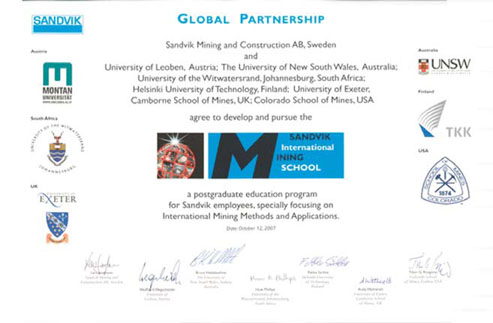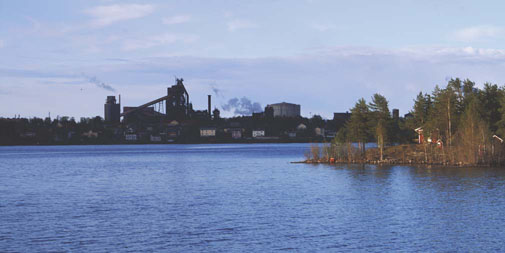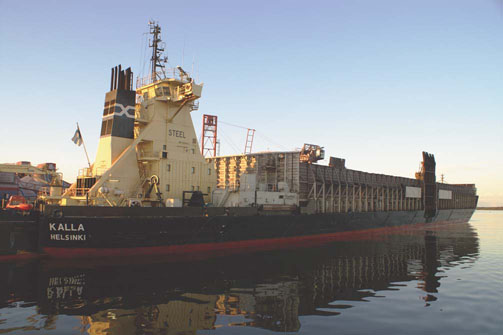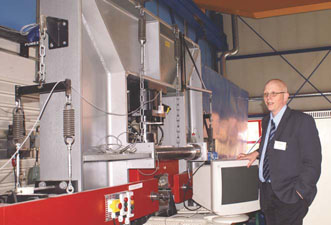
Europe Advances Educational Efforts in Mining Engineering
Several notable education and R&D initiatives are aimed at keeping the
region’s
miners and equipment suppliers at the top of the technology heap
By Kyran Casteel, European Editor

The program initially covered only Mining Engineering but later added Mineral Engineering and Geotechnical and Environmental Engineering, creating the Erasmus Mundi (initially European Mining) Minerals and Environmental Program (EMMEP). The number of participating institutions increased to nine and in 1999, relations between the participants were formalized when the Federation of European Mineral Programs (FEMP) was established. The course is well-supported by the industry and assisted by specialists from other universities. For example, the Helsinki component includes time at Outokumpu’s Kemi mine and lectures by Professor Kumar of the Luleå Technical University in Sweden. FEMP said the logical next step is cooperative research, which will necessitate developing appropriate themes.
A very recent and unique industrialacademic initiative was launched on October 12, 2007 by Sandvik Mining & Construction and six universities. TTK is again involved, together with fellow EMMEP participant the Camborne School of Mines (part of Britain’s University of Exeter), the Colorado School of Mines in the United States, the University of New South Wales in Australia, the University of the Witwatersrand in South Africa, and the Mining University of Leoben in Austria, in which Sandvik’s Materials Handling business is based.
The “Sandvik International Mining School” offers six modules that will combine theoretical education and practical field work to provide international experience. Each university will offer courses utilizing their special field of expertise and Leoben will coordinate the program. The post-graduate “International Mining Engineer” course is intended principally for Sandvik employees who are engineering graduates interested in gaining an additional qualification in mining engineering and who seek to learn about the economic and social environment of this industry. The company has already made significant investments in technician training for its own and customer employees.
Noting that this is the first such partnership to offer professional training at the university level to interested employees, Sandvik Mining & Construction’s Vice President–Human Resources, Klaus Sapetschnig, said: “The extra knowledge gained will give our employees a considerable competitive edge.”

Constructing the Triple Helix
Concern with how to achieve the quantity
and quality of research and development
needed to sustain the Nordic mineral
industry for all the stakeholders is
not confined to the industry itself. At the
turn of the century, the community of
Malå, in Västerbotten, Sweden, initiated
the Georange initiative to promote superior
technology and encourage research
on behalf of society. In 2000, Georange
was planned as an EU-funded project
managed by a non-profit organization. By
2002, some 17 research programs were
being funded.
Another prominent R&D sponsor is MITU, the mining industry-backed Swedish Mining Research Foundation, while one of the several universities in the region teaching geology, mining and metallurgy—and probably the one most focused on applied research related to the mining sector—is the Luleå University of Technology (LTU), located in the same northern city as the LKAB headquarters and SSAB steelworks.
In June 2004, the Swedish government presented a new initiative called Innovative Sweden: A strategy for growth through renewal. This postulated that the country should become Europe’s most competitive, dynamic and knowledgebased economy, and that Swedish metallurgy, plus the mining, minerals and stone industries, should become the most competitive in Europe. The three strategy themes are Research and Development, Skills Provision and Sustainable Development. The R&D strategy included a steel research program and a mining research program, both supervised by Vinnova, the Swedish governmental agency for Innovation Systems, energy research led by STEM, and geoscience research plus a program for industrial minerals, aggregates and dimension stone stewarded by the Swedish Geological Survey.
During 2005, two new collaborative organizations were established. On the one hand the mining companies Boliden and LKAB, equipment supplier Atlas Copco, general contractor NCC and geoinstrumentation supplier Reflex joined forces to create the Rock Tech Center, which took over the work of the, by then, unfunded Gällivare Hard Rock Research project in Gällivare. At much the same time the triple helix of society (initially represented by Georange), the industry (similarly represented by MITU), and academia, in the form of LTU, in consort with other major research organizations, banded together to establish Bergforsk as an arena in which to facilitate joint and continuous development of effective research strategies. Bergforsk started functioning in June 2005 and is, said Göran Bäckblom, managing director of MITU, a virtual research institute that has been successful in prioritizing research initiatives.
In 2005, the European Commission launched a Technology Platform on Sustainable Mineral Resources (SMR) where enterprises, the European sector organizations in the extractive industries (coal, oil, gas, ore-based industry, industrial minerals, aggregates, natural stone) and the geological authorities’ cooperative bodies are together developing a Vision 2030 and a Strategic Research Agenda. The industry and other actors in the sector take a positive view of active participation in the framework programs to strengthen the university and create new values which an individual actor is not capable of achieving. Swedish companies, LTU and Georange are participating very actively in the work. LKAB, for example, is responsible for one focus area (new materials and products) and Boliden for another (reuse, recovery and recycling of metals and minerals). LTU plays a leading role in the planning of exploration research as well as in the planning of research for new materials and products. Georange plays a prominent role in the interaction between the mining and minerals industry and society and, with regard to regional development, has shed light on important aspects of the interaction between the mining industry and society as a whole.
The Swedish government decided during September 2006 to launch a Mining Research Program within the framework of Sector Negotiations. Vinnova was granted SEK50 million ($7.8 million) through 2006–2010 on the condition that the industry contributes at least half of the cost of the total program. An agreement was settled between Vinnova and MITU.
The Bergforsk Agenda
Bergforsk says the industry’s general
strategies for sustainable competitiveness
are:
• World-leading and efficient research,
development and education;
• Sustainable and reliable raw material
supply to the mineral and metal
industry in consideration of the geological
opportunities in Sweden;
• Well-developed capability for acting
on the world market in niches with
high value-addition;
• Work for a regulatory framework that permits
growth and do not create disadvantages
for international competitiveness;
• Reduced energy use and more efficient
systems for reuse, recovery and recycling,
plus increased production of inexpensive
electricity in Sweden; and
• Strengthening of Sweden's mining
regions.
Tactical initiatives include making LTU a strong European university with strong and successful research groups and therefore investing in research centers at this university rather than creating a new industry research institute. The research centers are run jointly by the industry and LTU in cooperation with selected other universities and offer many opportunities for creating new initiatives within a relatively flexible and efficient framework. One recent addition is the Hjalmar Lundbohm Research Center for Mining and Metallurgy. Established with a SEK 100 million ($15.6 million) donation by LKAB, the Center is performing research that supports the company’s strategies in three main areas—sustainable iron ore production, intelligent pellets and new products. During 2007, LTU added ROMEO, a research center on mining and the environment: the steering committee comprises the environmental managers at Boliden, LKAB and Lundin Mining and senior staff at LTU, and the University of Umeå, also in Sweden. ROMEO is presently defining projects for the new Mine Research Program financed by the industry and Vinnova.

The basic prerequisite for raw material supply, said Bergforsk, is exploration. Here it is proposed that a research center, the Center for Applied Ore Geology, be founded at LTU, which will build 4- dimensional geological models of mature orefields such as the Skellefteå Field, Bergslagen and the orefields in Norrbotten. This project is also included as a project in the Technology Platform on Sustainable Mineral Resources, which builds further on the research funded via Georange.
A big operating cost for mines and infrastructure construction is drifting and tunneling. Bergforsk believes that the cost can be considerably reduced and therefore planned a project “Faster and Better Tunneling” of great benefit to organizations such as the National Rail Administration, the National Road Administration and Svensk Kärnbränslehantering AB (the Swedish Nuclear Fuel and Waste Management Co.). The work is being pursued under the direction of Rock Tech Center.
The industry is also pursuing a program for rock fragmentation where research by the mining industry complements research in the aggregate industry (MinBasII). The research on fragmentation is important not only to improve competitiveness, but also to conserve natural resources by minimizing wastage, while at the same time enabling new products and materials to be produced. Particularly urgent areas are methods for determining blastability and grindability in the downstream processes as a function of rock properties, and developing energy-efficient systems for extreme fine grinding. System models for blasting and grinding also need further development; this work is being carried out at the Swebrec Blasting Research Center.
Development of new materials and products is an urgent focus area in the Technology Platform on Sustainable Mineral Resources, and the Promote research centre at Luleå University of Technology plays a leading role for the entire European mineral industry (metals, industrial minerals, aggregates, natural stone, oil and gas, etc.). Essential projects are increased knowledge of the functionality of materials, for example which material properties are essential for the strength of iron ore pellets before and after reduction in the blast furnace, and how mineral separation can be increased in flotation. One of Promote's principal tasks is also to develop more efficient innovation processes in the industry, and this work is being pursued within the framework of the aforementioned technical projects.
Reuse, recovery and recycling is an important part of the Technology Platform on Sustainable Mineral Resources, where Boliden is leading the work. One big project (Mimer) focused on minimization, recycling and reuse of waste products from the mineral and metal industry. Recovery and recycling of valuable metals and minerals from end-of-life products has been completed.

Research and development to reduce the environmental impact in mining activities is directed to five projects: waste management and disposal methods; recipient impact; site remediation; and social aspects.
The Force in Luleå
In May of this year, Bergforsk members
and guests gathered at the university in
Luleå to review progress. LTU staff and
students reported on research projects,
such as Modeling of Failure in Rock:
Recent Developments, presented by
Professor Erling Nordlund, who is also
chairman of next year’s Massmin conference
and exhibition at the University.
Jerker Delsing, professor of Industrial
Electronics covered Embedded Systems
for Extreme and Harsh Conditions—
Present Status and Outlook for the
Future. LTU’s President Pia Sandvik
Wiklund overviewed the present status
of mining R&D and education at the
university.
From industry and government, Per Eriksson, the director general of Vinnova and Ulf Marklund of Boliden reviewed the Mining Research Program’s progress; Sverker Hartwig discussed R&D at Atlas Copco CMT where he is vice-president Technology; and Martin Ivert, who is chairman of SweMin as well as CEO of LKAB, presented Industry Perspectives in R&D to Maintain Technological Leadership. From the outside looking in, Deming Whitman, who is CEO of Amira International in Australia, counseled caution in relying heavily on regional cooperation, pointing to the success of the international research brokering model that Amira has employed on behalf of its mining industry clients (definitely more network than cluster).